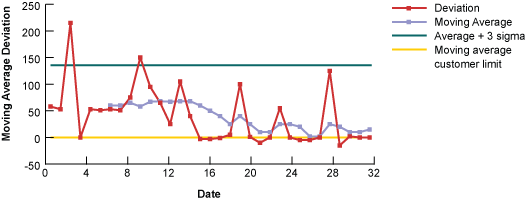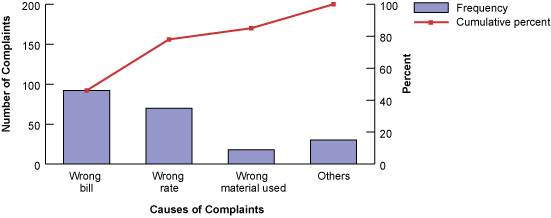
Quality in the total quality management (TQM) method is defined as customer delight. Customers are delighted when their needs are met or exceeded. The needs of the customer are:
- Product quality
- Delivery quality
- Service quality
- Cost value
Improving customer service was the focus of two projects within the deployment of TQM in a mid-sized newspaper in India. This is the second piece in a three-part series of articles featuring case studies from that deployment; Part 1 of the series featured projects leading to improvements in product quality. Part 3 looks at supply-chain improvements.
Reducing Advertisement Processing Time
The newspaper closed its window for booking advertisements at 4 p.m. every day. However, many of the newspaper’s advertisers expressed that they would be delighted if this limit could be extended to 5 p.m., as they were not able to send ad materials on time for the 4 p.m. deadline.
The TQM leaders formed a team consisting of representatives from each link in the ad-processing chain of work. The team attended a two-day quality-mindset program to expose them to the concepts of TQM and also to open their minds about experimenting with change.
Defining the Problem
In TQM, problems are defined as Problem = Desire – Current status. Therefore, in this case:
Problem = Desired closing time – Current closing time = 5 p.m. – 4 p.m. = 60 minutes
The 4 p.m. deadline had been instituted because:
- Deadline for sending the ad pages to the press was 6:30 p.m.
- Standard cycle time for processing ads into pages was 2.5 hours
Achieving a 5 p.m. ad closure deadline meant reducing the standard ad processing time by 40 percent, or one hour. To define the current state, the actual time spent preparing pages to go to press was collected over several days.
Defining the metric: If T = (page processing time – page-to-press deadline), then for 99.7 percent on-time delivery, or 3 sigma performance, the average T + 3 standard deviations of T should be less than 0.
Measure the current state: The ad closing deadline could not be delayed by an hour without delaying the dispatch of the newspaper to press by an equivalent amount. Therefore, the current state was calculated by measuring the delay compared to a notional 5:30 p.m. dispatch time rather than the actual deadline of 6:30 p.m. Calculations showed that:
- Average T = 72 minutes
- Average T + 3 sigma of T = 267 minutes
The problem was defined: reduce 267 minutes to less than 0 minutes.
Analyzing the Problem
The team monitored the time spent on each activity of the ad process (Table 1).
| Table 1: Time Spent on Ad Process | |
| Activity | Deadline |
| Ad receiving | 4 p.m. |
| Dummy “dump” | 4:30 p.m. |
| Pagination complete | 6:30 p.m. |
During the 4 to 4:30 p.m. period, ads received at the last minute were still being processed. At 4:30 p.m., the material was dumped into the layout for pagination, meaning arrangement on the newspaper pages using software and manual corrections. To achieve the objective of a 5 p.m. ad content deadline, the pagination time had to be reduced.
Brainstorming why pagination took two hours produced three possible major reasons:
- Error correction
- Delayed receipt of ad material for a booked ad
- Last-minute updates from advertiser
All this work was carried out after the last ad was submitted. Team members suggested that if ads were released for pagination earlier, removing errors could begin simultaneously with the processing of the last ads in order to reduce cycle time. They agreed to give two early outputs at 3:30 and 4 p.m., before the final dump at 4:30 p.m.
Testing the Ideas
| Table 2: Problems with New Process | |||
| Problem | Effect | Root Cause | Solution |
| Missing material removal | 15 to 30 min. | Material delayed or not received | Only feed ads once all materials received |
| Error file found after last release | 10 min. | Not checking pre dump | Check for errors pre dump |
| Special placement instructions not followed | 10 min. | Processing team not aware of special instructions | Give instructions as received |
| Distorted ads in PDF | 15 min. | Ads not corrected before feeding | Correct before feeding, include in SOP |
| Ads inserted post pagination completion | 20 min. | Ads accepted after deadline | Enforce deadline |
| Total time savings possible | 70 to 85 min. | ||
The process was repeated four times (Table 3).
| Table 3: Further Process Observations | |||
| Problem | Effect | Root Cause | Solution |
| Observation 2 | |||
| Repeating old practices | Reiterate SOPs | ||
| Scanning of materials delayed | 45 min. | Agree on scan turnaround time | |
| PDF conversion problem | 15 min. | Programming problem | IT to resolve |
| Zip error file not scanned | Zip not required | ||
| Observation 3 | |||
| System failure at peak time | 75 min. | Use back-up system | |
| Observation 4 | |||
| Add-on section integration delayed | 25 min. | Start integration in pre-dumps | Add to SOP |
Checking the Results
Nine weeks of continuous implementation yielded dramatic improvement. Average processing time was reduced by an hour, from 72 minutes to 12 minutes. However, the level of variability, although 50 percent lower, was still unacceptable. Analysis of the variability showed that it was largely due to slip-ups in implementing the SOPs.
Standardizing Controls
The team used an x-bar control chart (Figure 1) to monitor and improve performance regularly.

Gradually the performance improved. Two months after implementation, delivery time had progressed from 267 minutes late to 12 minutes early. The deadline for receiving ads could now be relaxed to 5 p.m., delighting the advertisers.
Reducing Customer Complaints
Management indicated that the number of credit notes given to advertisers was too high. Credit notes, issued to rectify errors made in sales invoices, were used to fend off considerable customer annoyance. But this system caused trouble for the paper. Besides increasing non-value-added work, credit notes sometimes resulted in financial loss because customers could use the credit toward ads that had already been booked as sales.
During the previous 12 months, the newspaper had received 80 credit notes per week. The team agreed to try to reduce that number by 50 percent in Phase 1.
Finding the Root Causes
About 200 credit notes were examined to determine why they had been issued. Categorization of the causes was charted in a Pareto (Figure 2).

Three causes constituted 84 percent of the problem:
- Wrong billing – 46 percent
- Wrong rate – 24 percent
- Wrong material used – 14 percent
Table 4 shows the root causes of a majority of the credits issued, determined using the 5 Whys method, and their corresponding countermeasures.
| Table 4: Explanation of Credit Causes and Countermeasures | |||
| 1st Why? | 2nd Why? | 3rd Why? | Countermeasure |
| Wrong billing | Unbilled charge picked up; Discount applied incorrectly to all ads in series | System bug | Removed |
| Wrong rate | Sales scheme not in sales card; Old scheme continues after updating of sales rate card; Scheme in rate card but not picked up by system | Sales cards not updated; Bill system does not pick up entry | SOP |
| Free ads billed | System does not pick up operator entry | Modify system to pick up operator’s entry when prompted, rather than automatically taking billing information from the rate table. | |
The team tested the ideas, which resulted in an 80 percent reduction in credit notes, from 80 per week to 14 per week. The process was adopted in regular operation, and the results were documented and presented to senior management.
Change in Thinking
TQM often leads to radical changes in employee mindsets. The improvements resulting from the two customer service-related projects helped to create a team environment in which any change idea is easily accepted, tested and – if it works – implemented.